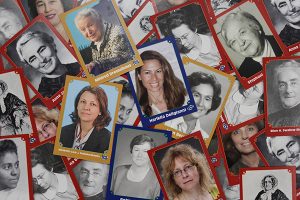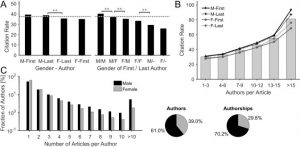Change isn’t easy. For women, it took lobbying, protests, campaigns, and even jail time to receive the right to vote. It wasn’t until August 26, 1920, when women’s fight for change finally paid off. The Nineteenth Amendment was added to the United States Constitution, giving women the right to vote as citizens of the United States, regardless of their sex. Today, we celebrate women, their achievements, and the continued need for change.
Starting with the sciences. A recent study revealed that articles with male key authors are more frequently cited than articles with female key authors. Articles with a female key authorship are on average below the mean citation rate of 37.5 citations/article. According to the Nature Research Journal, numerous studies across various scientific fields also revealed the same, such as astronomy, whose publications with female first authors received roughly 10% fewer citations than do those with male first authors.
Unfortunately, because female scholars are at a disadvantage when it comes to citation practices, this results in serious long-term consequences for their careers. Highly-cited publications in top-ranked journals remain the most important factor in hiring and promotion decisions, affecting women’s career success in academia and minimizing diversity in the field, classrooms, and future. For example, in 2011, only 15% of full-time professors in political science in the UK were women (far fewer than the percentage of women in the field overall — 31%), according to Wiley Online Library. In addition, a study by Jeff Colgan, an assistant professor from Brown University, revealed that university graduate students received syllabi with reading lists made up of 82% all-male authors, creating a gender gap in university curricula.
Jan Talbot, a chemical engineer, and a former ECS board vice president, president, and Interface editor, experienced this firsthand as the first women hired in her department at the University of California San Diego. Throughout her career, she continued to achieve many similar firsts, as one of the few women in her field.
“Since the beginning of my career I realized the responsibility of being one of a few women to follow this path,” says Talbot.
This passion and commitment to her career has made Talbot a trailblazer of the sciences. She’s contributed countless research papers to the ECS Digital Library and hopes to contribute her body of work to help advance the sciences, as part of the Free the Science initiative. Driven by ECS, Free the Science aims to make academic’s research free and completely available to the public. This is especially vital to female authors, as complete access to their research means more citations and a step towards equality in their field.
As part of the Free the Science movement, ECS is working towards making all of Jan Talbot’s 48 articles permanently free to read. Sharing her body of work will help advance science, while also promoting women’s contributions to the field. So today, in honor of Women’s Equality Day, we ask you to make your mark in history: donate to free Jan Talbot’s collection. Help change the future of science.




